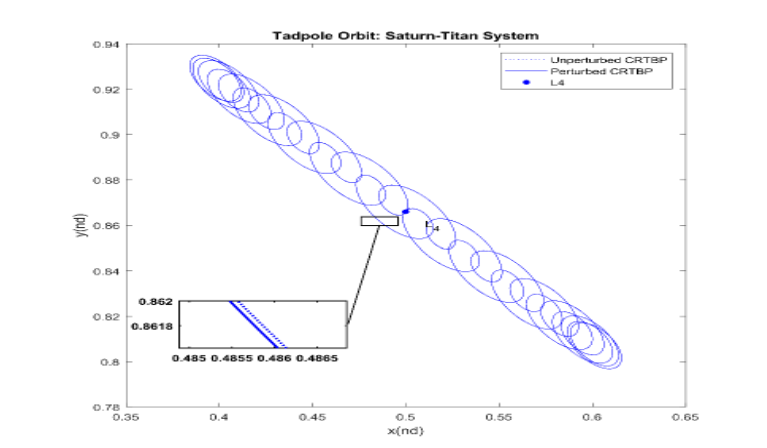


Indian Journal of Science and Technology
DOI: 10.17485/IJST/v13i39.1396
Year: 2020, Volume: 13, Issue: 39, Pages: 4168-4188
Original Article
A Arantza Jency1*, Ram Krishan Sharma1, Gagandeep Singh1
1Department of Aerospace Engineering, Karunya Institute of Technology and Sciences, Coimbatore, 641114, Tamil Nadu, India. Tel.: +91-9566406224
*Corresponding Author
Tel: +91-9566406224
Email: [email protected]
Received Date:13 August 2020, Accepted Date:21 October 2020, Published Date:09 November 2020
Background: The location and stability of the equilibrium points are studied for the Planar Circular Restricted Three-Body Problem where the more massive primary is an oblate spheroid. Methods: The mean motion of the equations of motion is formulated from the secular perturbations as derived by(1) and used in(2–4). The singularities of the equations of motion are found for locating the equilibrium points. Their stability is analysed using the linearized variational equations of motion at the equilibrium points. Findings: As the effect of oblateness in the mean motion expression increases, the location and stability of the equilibrium points are affected by the oblateness of the more massive primary. It is interesting to note that all the three collinear points move towards the more massive primary with oblateness. It is a new result. Among the shifts in the locations of the five equilibrium points, the y–location of the triangular equilibrium points relocate the most. It is very interesting to note that the eccentricities (e) of the orbits around L1 and L3 increase, while it decreases around L2 with the addition of oblateness with the new mean motion. The decrease in e is significant in Saturn-Mimas system from 0.95036 to 0.87558. Similarly, the value of the critical mass ratio mc, which sets the limit for the linear stability of the triangular points, further reduces significantly from 0:285: : :A1 to 0:365: : :A1 with the new mean motion. The mean motion sz in the z-direction increases significantly with the new mean motion from 9A1/4 to 9A1/2.
Keywords: Circular Restricted Three-Body Problem (CRTBP); oblateness; mean motion; equilibrium points; critical mass ratio; tadpole orbits
© 2020 Arantza Jency et al.This is an open-access article distributed under the terms of the Creative Commons Attribution License, which permits unrestricted use, distribution, and reproduction in any medium, provided the original author and source are credited. Published By Indian Society for Education and Environment (iSee).
Subscribe now for latest articles and news.